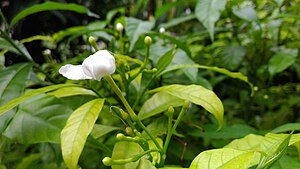Note: This is a project under development. The articles on this wiki are just being initiated and broadly incomplete. You can Help creating new pages.
Tabernaemontana divaricata - Nandyavarta
Tabernaemontana divaricata is a plant is placed in front of the home is the sign of wealth. Five petals having Nandyavarta is having special medicinal features. It is also used for worshiping god.
Uses
Wounds, Cuts, Snakebites, Liver disorders, Skin eruptions, Blotches, Pimples, Diarrhea, Sore throats
Parts Used
Chemical Composition
Voafinidine (C20H28N2O2) and voalenine in minor amounts and a new 2-acylindole alkaloid, ervaticine. Coronaridine, voacristine, tabernaemontanine, dregamine; α-amyrin, lupeol, β-sitosterol, voacangine and voaphylline have also been isolated from leaves[1]
Common names
| Language | Common name |
|---|---|
| Kannada | |
| Hindi | |
| Malayalam | |
| Tamil | |
| Telugu | |
| Marathi | NA |
| Gujarathi | NA |
| Punjabi | NA |
| Kashmiri | NA |
| Sanskrit | |
| English | Crape jasmine |
Properties
Reference: Dravya - Substance, Rasa - Taste, Guna - Qualities, Veerya - Potency, Vipaka - Post-digesion effect, Karma - Pharmacological activity, Prabhava - Therepeutics.
Dravya
Rasa
Tikta (Bitter), Kashaya (Astringent)
Guna
Laghu (Light), Ruksha (Dry), Tikshna (Sharp)
Veerya
Ushna (Hot)
Vipaka
Katu (Pungent)
Karma
Kapha, Vata
Prabhava
Habit
Identification
Leaf
| Kind | Shape | Feature |
|---|---|---|
| Simple | opposite | The leaves are oval, 8 to 15 cm (3 to 6 in) long, dark glossy green, prominently veined and have a leathery texture |
Flower
| Type | Size | Color and composition | Stamen | More information |
|---|---|---|---|---|
| Unisexual | 4 cm | Yellow | 5 | The flowers are trumpet-shaped, about 4 cm (1.6 in ) across, with five waxy white petals in a pin-wheel arrangement. |
Fruit
| Type | Size | Mass | Appearance | Seeds | More information |
|---|---|---|---|---|---|
| General | 7 cm | The fruit are rare but when produced are curved, ribbed | six | {{{6}}} |
Other features
List of Ayurvedic medicine in which the herb is used
- Vishatinduka Taila as root juice extract
Where to get the saplings
Mode of Propagation
How to plant/cultivate
A plant of tropical and subtropical areas, growing at low to medium elevations. Succeeds in full sun to partial shade Prefers a fertile, moist but well-drained soil[3]
Commonly seen growing in areas
Photo Gallery
References
External Links
- Ayurvedic Herbs known to be helpful to treat Wounds
- Ayurvedic Herbs known to be helpful to treat Cuts
- Ayurvedic Herbs known to be helpful to treat Snakebites
- Ayurvedic Herbs known to be helpful to treat Liver disorders
- Ayurvedic Herbs known to be helpful to treat Skin eruptions
- Ayurvedic Herbs known to be helpful to treat Blotches
- Ayurvedic Herbs known to be helpful to treat Pimples
- Ayurvedic Herbs known to be helpful to treat Diarrhea
- Ayurvedic Herbs known to be helpful to treat Sore throats
- Herbs with Dried folaige used in medicine
- Herbs with Whole herb used in medicine
- Herbs with common name in English
- Habit - Evergreen Shrub
- Index of Plants which can be propagated by Seeds
- Index of Plants which can be propagated by Cuttings
- Herbs that are commonly seen in the region of Mountain areas
- Herbs that are commonly seen in the region of Sparse forest areas
- Herbs



